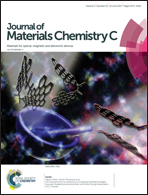A computational study of hydrogen detection by borophene
Abstract
In this work we present a quantum-classical molecular dynamics study of hydrogen irradiation of a single corrugated boron sheet in the incident energy range of 0.25–100 eV and report the resulting reflection, adsorption, and transmission probability. For this we use self-consistent charge tight binding density functional theory. A comparison of the irradiation results with our previous study on hydrogen detection using graphene shows a significant increase in the adsorption probability and a lower reflection rate for borophene. We benchmark our method of finding the interaction potentials of hydrogen and the boron sheet with plane wave density functional theory for validating our approach. We utilized the open boundary non-equilibrium Green’s function method to obtain conductivity of borophene as a function of hydrogen coverage. For voltages of up to 300 mV the systems have a linear volt–ampere characteristic and the resulting conductance decreases exponentially as a function of the hydrogen coverage. Our results suggest that borophene has favorable properties for its use as a hydrogen detector.



 Please wait while we load your content...
Please wait while we load your content...